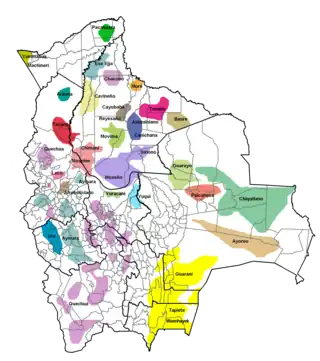| Canichana | |
|---|---|
| Joaquiniano | |
| Native to | Bolivia |
| Region | Beni Department |
| Extinct | ca. 2000 |
Tequiraca–Canichana?
| |
| Official status | |
Official language in | |
| Language codes | |
| ISO 639-3 | caz |
| Glottolog | cani1243 |
| ELP | Canichana |
 Historical distribution of the language | |
Canichana, or Canesi, Joaquiniano, is a possible language isolate of Bolivia (department of Beni). In 1991 there were 500 Canichana people, but only 20 spoke the Canichana language; by 2000 the ethnic population was 583, but the language had no L1 speakers left.
It was spoken on the Mamoré River and Machupo River.[1]
Language contact
Jolkesky (2016) notes that there are lexical similarities with the Mochica language due to contact.[2]
Vocabulary
Loukotka (1968) lists the following basic vocabulary items for Canichana.[1]
gloss Canichana one mereka two kadita three kaʔarxata tooth eu-kuti tongue au-cháva hand eu-tixle woman ikegahui water nese fire nichuku moon nimilaku maize ni-chuxú jaguar ni-xolani house ni-tikoxle
See also
References
- 1 2 Loukotka, Čestmír (1968). Classification of South American Indian languages. Los Angeles: UCLA Latin American Center.
- ↑ Jolkesky, Marcelo Pinho de Valhery (2016). Estudo arqueo-ecolinguístico das terras tropicais sul-americanas (Ph.D. dissertation) (2 ed.). Brasília: University of Brasília.
External links
Wiktionary has a word list at Appendix:Canichana word list
- (in French) La Langue Kaničana
- Lenguas de Bolivia Archived 2019-09-04 at the Wayback Machine (online edition)
- Canichana transcriptions of GlobalRecordings audio files
This article is issued from Wikipedia. The text is licensed under Creative Commons - Attribution - Sharealike. Additional terms may apply for the media files.
